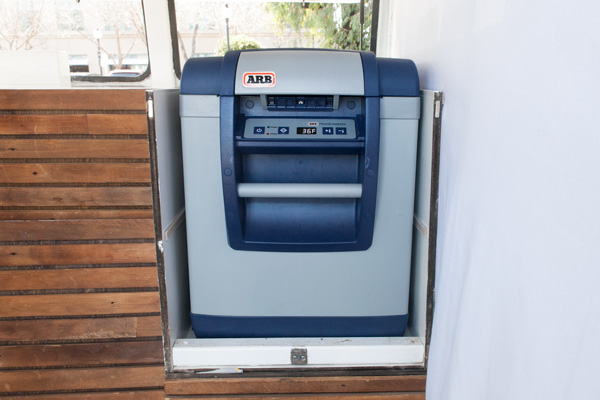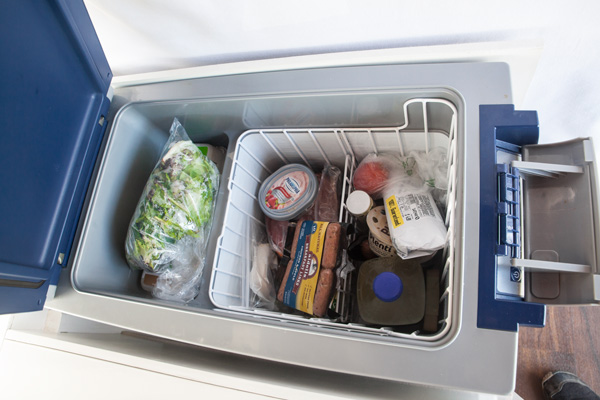A number of things are required to turn a camper into a livable, comfortable home. These are a few of my picks, as well as some inexpensive alternatives.
Fridges
My Choice: ARB 50qt Fridge Freezer. The portable fridges made today are light years beyond what you may find in a dingy RV made 10 or 15 years ago. The biggest improvement is that they consume a small fraction of electricity compared to their predecessors. What I like about ARB’s fridge is that since it’s made by a 4x4 accessories company this fridge can withstand anything thrown at it. Not to mention it has a refined design that makes it simple to use, and enough space to store a week or more worth of food. While I power this most of the time with my solar, I’d recommend buying a 12v cigarette lighter plug to power the fridge on long drives or when your solar is running low. ($850 new / Amazon)
The Alternative: Coleman 40qt Powerchiller. If a fridge and ice cooler had a child, the Powerchiller would be that offspring. It’s got a small-form factor and the convenient ability to use it like a traditional chest cooler or upright like a small refrigerator. The downside to this option is that it only refrigerates it’s contents to 40° below the surrounding temperature. Since you want to keep any meats and dairy below 40° F it would not be advisable to use this to refrigerate if it’s 80° or higher inside your van (this would bring the internal temperature of the Powerchiller above the necessary 40°). Take into account that during the summer, the inside of your van can get twenty to thirty degrees higher than the outside temperature. ($100 new / Amazon)
Stoves
My Choice: Origo 2-burner Alcohol Stove. I’m incredibly cautious when it comes to propane and carbon monoxide—as you should be. So when I found out the Coleman propane stove I originally bought would need some alterations to the propane connector and a number of third-party adapters just to fit into it’s place in my kitchen unit, I started looking for other options.
Luckily, I stumbled upon alcohol stoves! Mainly used on boats, an alcohol stove runs off denatured alcohol (which you can buy at almost any hardware store) and is much safer in an enclosed space than propane (not pressurized or silently leaking carbon monoxide). I will occasionally get a tiny bit of irritation in my eyes from the alcohol which is solved by cracking open the window or roof fan. Ventilation is a good idea anyways when cooking. Even though I use the stove almost everyday to cook I’ve probably only spent around $30 on the alcohol fuel in the last six months. Not bad at all. The build quality of the Origo stove is also outstanding. Truely built to last. Much better than any Coleman stove I owned. ($240 new / Amazon UK)
The Alternative: Single Burner Butane Table Top Stove. I don’t know much about these, but have met other people that use them. They’re small and can be stored easily. The small bottles of butane can be pricey and you run the risk of CO fumes. If you decide to go this route please use proper ventilation. ($30 new / Amazon)
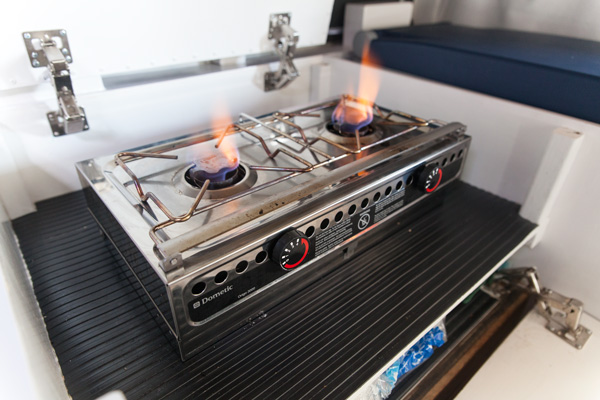
Love with this stove. Cranks the heat, is incredibly rugged and painless to clean.
Heater
My Choice: Mr. Heater Portable Buddy Propane Heater. Options are more limited when it comes to effective heaters. This Mr. Heater uses 1lb propane cylinders and really cranks out the heat. In just a few minutes of being on it’ll heat up the inside of the van to a comfortable temperature. It’s approved for both outdoor and indoor usage, however, I recommend always checking the regulator connection with a little soapy water anytime after the propane cylinder is swapped out. The heater also includes auto shut-off if tipped over, if pilot light goes out, or if detects low oxygen levels. Good news for safety nuts like me. If I use it for 10 minutes a couple times during the night a single bottle of propane will last 2 to 3 nights. If used less or on a lower setting, it can last much longer. It also has the option to connect to a larger propane tank via hose ($85 new / Amazon)
The Alternative: Mr. Heater Lil’ Buddy. The smaller brother of the above heater. Less heat but still comes with the low-oxygen sensor and auto shut-off for safety. It will heat continuously for around 5 hours. ($60 new / Amazon)
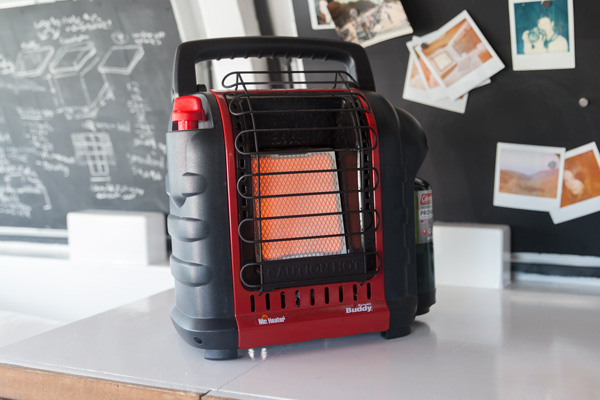
You won’t know how much you really need a heater until you’re sleeping in a van that gets down to below 40 degrees during the winter.
Solar systems
My Choice: Goal Zero Yeti Solar Generator and Boulder Panels. The Goal Zero brand is doing everything right. They’re one of the first companies to bring high-quality solar products to consumers with a focus on outdoor enthusiasts. I use two Boulder 90 solar panels on the roof (for a combined 180w) that charge a Yeti 1250. This 1250w solar genrator powers my fridge, lights, fan, and battery chargers through easy plug-and-play 12v, 120v, power pole and USB inputs. I do find myself having to actively conserve energy in particularly overcast climates (the northwest or anywhere during winter), however, for most places and time of year this isn’t an issue. Goal Zero products range in size (aka power output), so you’ll be able to approximate your power usage and find something that works for you. ($400 to $2500 new / Amazon)
The Alternative: DIY solar system If Goal Zero is a bit out of your budget, you can attempt to build your own DIY solar system. You’ll need a solar panel, a controller, deep cycle battery, inverter and a whole lot of wiring. Some electrical experience is recommended. Don’t want to short your wires and cause a fire. ($250 and up / Amazon)
To learn a little more about my solar setup I recommend watching this video by the good folks at Huckberry. Their setup and Goal Zero gear is nearly identical to what I have in my van.
Fans
My Choice: Fantastic Vent - Model 7350. It’s pointless to consider any other brand for a roof fan. Fan-tastic Vent has been around forever and are used in most RV’s. The particular model I bought has adjustable speed, intake and outtake setting and a rain sensor (which has saved my forgetful butt multiple times). It’s power usage is efficient and the polycarbonate lid blocks some light, but still acts like a nice subdued skylight during the day. Overall no complaints except their incredibly confusing model numbers. Seriously Fantastic Vent, figure it out.
The Alternative: A window Since I use the fan less as a cooling tool and more as ventilation when cooking or just hanging out inside, a window could do the same. An open window is just less effective at pulling smoke out and you lose some privacy.
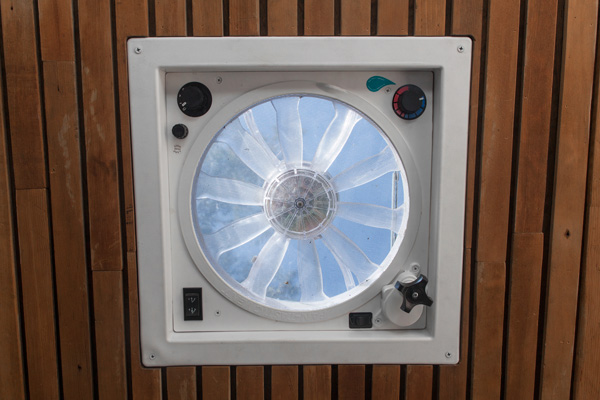
The most effective way to use this fan is to have a window or door cracked to allow the air inside to circulate. You’ll get a lot more power this way.
Water
My Choice: 5 gallon water jug. The one thing I decided not to go all out on was my water situation. I felt like a sink with two potable water tanks and a water pump would take up too much space in my kitchen unit and countertop. For hand-washing I decided to just use hand sanitizer and for dish washing I use natural and toxin free disinfecting wipes. For drinking water I found the perfect sized 5 gallon jug. Try to find one with a handle that isn’t flush with the spout so the handle doesn’t get in the way when closing the cabinet doors. ($40 new / Amazon)
The Alternative: Full sink and water pump. To build a sink you’ll need the sink/faucet unit which will be inset into the counter. Second you’ll need two water tanks—one for fresh water and one for used grey water. Finally you’ll need a water pump and some hose. Connect it all up and you should have a working sink. (Approx. $250 new / Amazon)
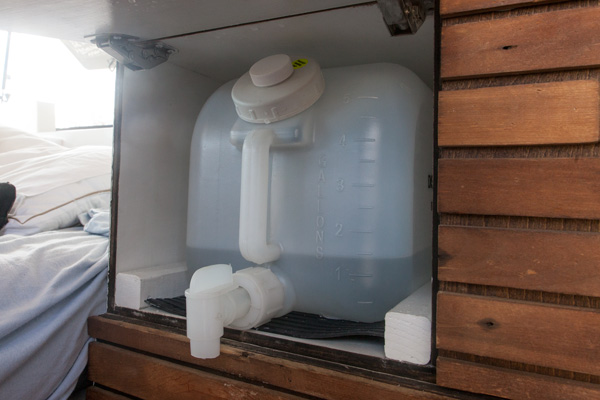
Simple to use and easy to fill up. Holds plenty of water for drinking and cooking.
Follow the adventure on Instagram
Proudly hosted by Media Temple.
©2016 All rights reserved.
